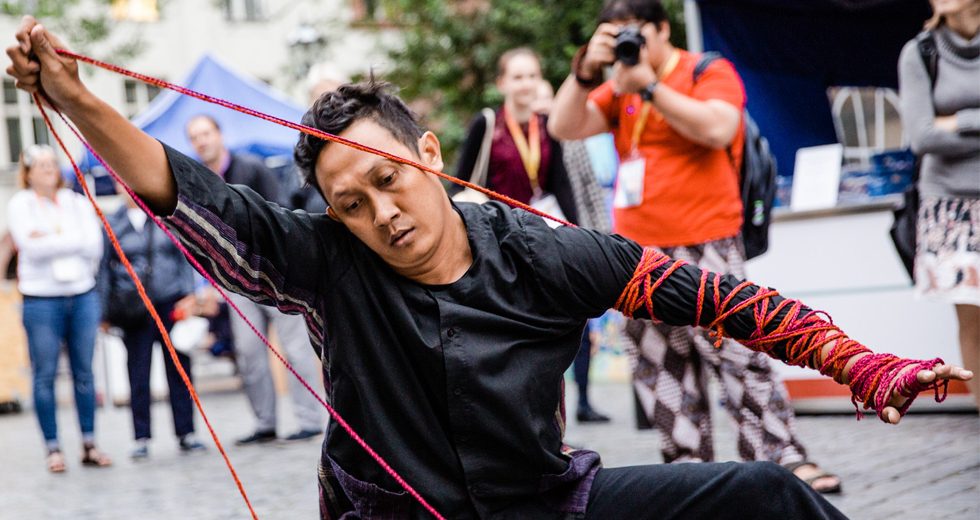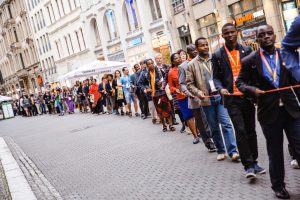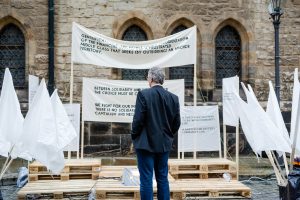A red thread links Council participants and artists on Leipzig’s Nikolaikirchhof
Posted on July 3, 2017 by Aiko Sumichan

By Amy Eckert. Photos by Anna Siggelkow.
Hundreds of General Council delegates joined in a silent walk from Leipzig’s Willy-Brandt Platz to the St. Nicholas Church on Saturday, July 1. In their hands they carried a portion of red thread knitted by women from a local senior center over the course of two weeks.
 In Asian myth, an invisible red thread connects people who are destined to be together. It’s a theme frequently depicted in Asian art, and it was an image that became fully visible to Council attendees Saturday evening when delegates jointly carried the 500-meter-long thread to the Nikolaikirchhof. Once there, Indonesian performer Elyandra Widartha danced with the thread, eventually winding its red, pink and burgundy hues around his arms, his neck and torso. Leipzig performing artist Heike Hennig spearheaded the project.
In Asian myth, an invisible red thread connects people who are destined to be together. It’s a theme frequently depicted in Asian art, and it was an image that became fully visible to Council attendees Saturday evening when delegates jointly carried the 500-meter-long thread to the Nikolaikirchhof. Once there, Indonesian performer Elyandra Widartha danced with the thread, eventually winding its red, pink and burgundy hues around his arms, his neck and torso. Leipzig performing artist Heike Hennig spearheaded the project.
The red thread formed the centerpiece of the artworks on the Nikolaikirchhof Saturday evening. Surrounding Widartha were half a dozen additional artists and their artworks, all of whom had spent the previous week sharing creative ideas and finding artistic inspiration around the themes of transformation and reformation. Works ranged from a vivid acrylic painting to creative video installations.
German artist Manaf Halbouni, originally from Syria, and Oscar HR of Spain collaborated on a piece called Freiräume. Focusing on the difficulties confronted by families displaced through gentrification, the video presentation depicted a local family faced by the issue in real life. They were recently asked to leave their existing apartment so the building might be refurbished for them to move back into in coming months.
“We told this family they were to select their most beloved objects—only enough objects to fit in their car—and place them in their apartment,” said Oscar HR. “So each piece has been chosen by one of the family members for some reason.”
In the video, a pile of their personal possessions sits covered by a plastic sheet. Slowly, the family members enter the scene, removing their belongings from the pile and replacing them around the room.
Guy Woueté, originally from Cameroon, spoke of his art installation called La dernière Marche. A platform sat in the shadow of St. Nicholas Church surrounded by white banners and placards denouncing racism and political oppression.
“I wanted to address democracy as a means to dismiss non-aligned opinions,” Mr. Woueté said. “We are always told, ‘Vote, you will change things.’ But we vote and then Parliament does what it wants and there’s nothing you can do but to wait another four years and vote again. You would need to live many lives to see any change in the world.”
For American artist Joel Schoon-Tanis, whose piece Who is My Neighbor? depicts the tale of the Good Shepherd with a cut-out space for attendees’ own faces, the chance to share creative ideas with his fellow artists was powerful. The event also gave him opportunity to consider the impact his personal faith might have on the resulting artwork.
“Europeans are big on social justice issues” explained Schoon-Tanis, “but they’re not generally very involved with the church. So I gave that a lot of thought here in Leipzig and decided to paint a more overtly Christian message in my piece than I might have otherwise.”
A second painting by Schoon-Tanis, also created during his week-long artistic collaboration in Leipzig, Peace Column, is on display outside the Plenary Hall at the Leipzig Messe.
More photos from the art project are accessible on our photo album.
 World Communion of Reformed Churches
World Communion of Reformed Churches